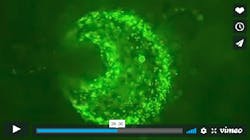Cancer therapy to advance with development of world's best video camera
The Rosalind Franklin Institute (Harwell, Oxfordshire, England) is funded to develop the world's best ultrafast video camera for imaging tissue with greater sensitivity and at higher resolution than any other instrument currently available. They say the camera will be invaluable in developing new techniques that use sound and light for both detecting and treating disease, including some of the most lethal forms of cancer such as pancreatic and brain tumors, with minimal side effects for patients.
RELATED ARTICLE: How to choose a high-speed camera
The new instrument will be developed through a collaboration between an academic team at the University of Oxford and a UK-SME specializing in high-speed imaging, Invisible Vision. Once completed, it will be housed at the new Rosalind Franklin Institute being built at the Harwell Research Complex in Oxfordshire for use by researchers in the UK and the rest of the world.
Chemotherapy is one of the most common treatments for cancer, using powerful drugs to kill cancer cells or stop them from growing and spreading to other parts of the body. These drugs are introduced into the bloodstream and absorbed into the surrounding tissue.
Professor Eleanor Stride from the University of Oxford, said, "A major challenge with current delivery methods for cancer drugs is that they rely on the active molecules reaching and entering the tumour cells by diffusion. This makes it difficult to ensure that all parts of a tumour are treated and leads to terrible side effects because large volumes of healthy tissue also absorb the drug. We need to find a better way to get these drugs into cancer cells specifically, quickly and effectively." She continues, "The approach we're developing introduces harmless particles into the bloodstream and then uses ultrasound to activate them, in order to both release the drug at a specific site and helping to drive it into the tumour to reach all of the cells within in it [see video below]."
The new instrument will be a key part of the core capability of the RFI's INSIGHT (imaging with light and sound) theme, which will be devoted to developing technology for imaging and therapy at the intersection of light and sound.
It will be the first camera in the world able to capture up to 100 million individual frames per second (fps) at 1 megapixel resolution and operate across a wide optical spectrum from ultraviolet to infrared. This one-of-a-kind camera will enable researchers to see how ultrasound interacts with drug-loaded particles and tissue and how that enables the uptake of drugs into cancer cells. The camera will help researchers to understand the biophysical mechanisms behind drug delivery--critical to perfecting ultrasound targeted drug delivery.
Currently, the fastest long-record-duration framing camera in the world best suited for these applications are still mechanical, operating at speeds up to 25 million fps. The new camera will be smaller and more compact (looking similar to a conventional video camera). It will be faster, more sensitive, and give higher resolution real-time imaging than any other device available today.
SOURCE: The Rosalind Franklin Institute; https://www.rfi.ac.uk/worlds-best-video-camera-to-develop-cures-for-deadliest-cancers/
About the Author

Gail Overton
Senior Editor (2004-2020)
Gail has more than 30 years of engineering, marketing, product management, and editorial experience in the photonics and optical communications industry. Before joining the staff at Laser Focus World in 2004, she held many product management and product marketing roles in the fiber-optics industry, most notably at Hughes (El Segundo, CA), GTE Labs (Waltham, MA), Corning (Corning, NY), Photon Kinetics (Beaverton, OR), and Newport Corporation (Irvine, CA). During her marketing career, Gail published articles in WDM Solutions and Sensors magazine and traveled internationally to conduct product and sales training. Gail received her BS degree in physics, with an emphasis in optics, from San Diego State University in San Diego, CA in May 1986.
